Tech News
-
Phanteks announced the new Glacier G2080 and G2080Ti GPU Waterblock for Nvidia RTX2080 and RTX2080Ti
Walnut, California, August 30th, 2018 – Phanteks today introduced their new full-cover waterblocks designed specifcally for the recently announced RTX2080 and RTX2080
Ti cards.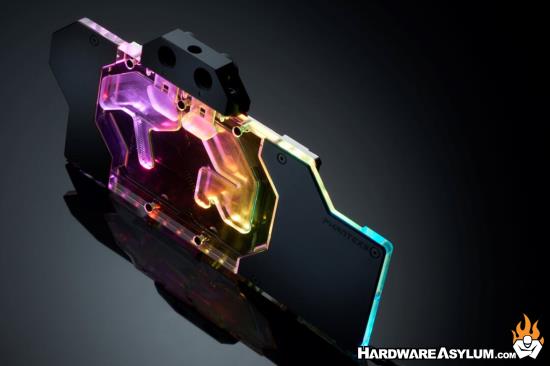
With a completely redesigned copper cold-plate and highly optimized fow routing, the Glacier 2080 waterblocks can handle all the overclocking potential the new RTX cards have to offer.
The Glacier 2080 waterblocks will be available in both Digital RGB and RGB and comes in Black and Chrome color options.
-
Beyerdynamic MMX 300 2nd Generation @ TechPowerUp
We were able to review these headphones shortly after CES and they were good. The biggest thing to note is that they are quite a bit bigger than standard gaming headsets which not only feels weird at first but also really enhances the sound stage at all levels.
The Beyerdynamic MMX 300 2nd Generation is the new iteration of the company's first gaming headset. It keeps the high price of its predecessor, but significantly improves upon all its key aspects, which makes it an interesting choice for exceptionally demanding gamers with big budgets.
I would have to agree on the budget comment. The MMX 300 is a rather expensive gaming headset and is one that many casual players will let pass by purely from cost alone. Sadly there is no way around that, if you want a quality headset you will eventually need to pay for it.
Be sure to check out our review of the MMX 300 before clicking over to read the TechPowerUp review.
-
The NVIDIA GeForce RTX 20 Series Graphics Cards Launched
Those of you who have listed in the Hardware Asylum Podcast back in May 2018 may have noticed that we talked extensively about how video cards were back on the market. If you didn’t catch the show be sure to check it out.
In that episode we talk about several reasons for why cards were back in stock and one of those was a rumor that a new NVIDIA card was set to be released. At the time everyone was grasping for any information about the new project and up until “now” nobody had it right. The name was wrong, the model number was wrong. In fact the only thing anyone got right was the name of the GPU architecture, Turing.
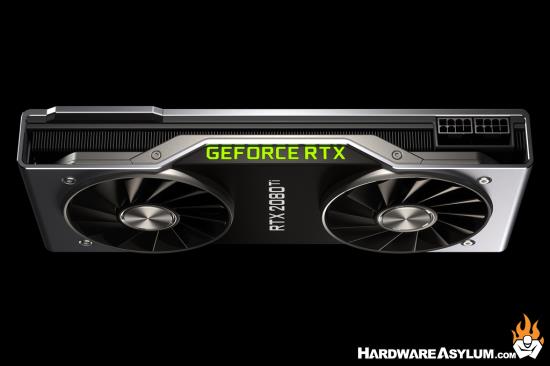
At Gamescom the NVIDIA CEO announced the new generation of GeForce graphics for gamers called the GeForce RTX. Unlike previous generations they are hitting the market with ALL of the halo chips including the RTX 2080, RTX 2080 Ti, RTX 2070 and RTX 2070 Ti. In the past the Ti editions would be a cash grab for after the early adopters exhausted the first release and it would seem this time around several things have changed.
Mind you I didn’t get any of this information from NVIDIA though I’m pretty sure they monitor everything I write so, maybe, just maybe I’ll get an email.
But, I digress
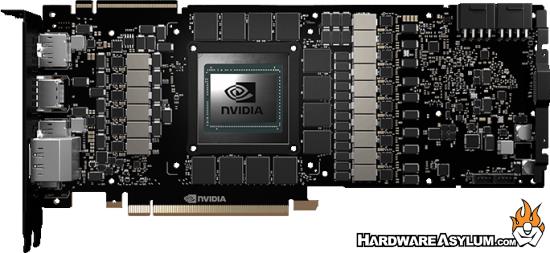
On to what I noticed from my arm chair
- I had already mentioned this but normal and Ti edition cards were announced at the same time. This is a major change in the NVIDIA release cycle and while they will stage the cards to market they were at least launched at the same time.
- The GeForce RTX 2080 Ti is $1200 USD!! Yes that’s right, twelve hundo. The GTX 1080 Ti was half that and I have a theory as to why. Well, two theories.
- Theory #1: Remember when there was a GPU shortage and retailers would price gouge buyers AND cash flush gamers would pay it? Well, guess what? those consumers (miners, gamers etc) provided to NVIDIA that people are willing to pay $1200 bux for a video card. On top of that even if gamers can’t afford to buy the card the miners will be fisting over cash trying to Pokemon every RTX they can find.
- Theory #2: There won’t be a Titan version (not likely) and the RTX 2080 Ti will take the spot while the Quadro cards will fill in the professional gap left by the Titan.
- The NVIDIA Marketing engine is running 120% to re-brand the new cards as the second coming for gamers. It is all about ray tracing and the ability to get most excellent graphics in real time. That is no small feat and I applaud them for making it happen however the brutal “in your face” “nobody listens to us cause we are only the leader in performance graphics” “blah blah something about certain generations not reading anymore, thinking YouTube is truthful, laptops are for gaming so, we had better hit them hard with messages they don’t understand” marketing seems a little extreme. #heyitworked
- There are actually some decent cards in the GeForce RTX line-up and at a reasonable price. You can get the RTX 2070 for $600 USD and there is promise that downmarket cards like the 2060 and 2050 will likely follow sometime later. Or, maybe that will be what all of the “extra” GTX 1080 Ti cards will end up becoming.
- The new heatsink design is pretty damn ugly however; I will say that for a factory cooling solution it is better than the old blower design.
- EVGA is doing some amazing things with RTX and will finally break into the 2.5 slot cooler designs. We can thank NVIDIA for removing 4-Way SLI for that little gem.
- Speaking of SLI I didn’t catch how what would work with the new Turing based cards. It seems to only be available on the 2080’s and will be using NVLink. NVIDIA has 4 slot bridges listed on the NVIDIA website so maybe that will be a thing, again?
- Finally, power the new GPUs are super sippy when it comes to power consumption. RTX 2070 @ 185W while the RTX 2080 Ti tops out @ 260W.
On the positive we have a new GPU on the market and that always makes me excited. This will expand what games can do, will push VR to the next level and might even bring back 3D Vision!! (Ha just kidding). As always I can’t wait to get a card in the lab and really see how powerful it is, how well it overclocks and learn more about the Turing architecture.
I’m also super excited to see how many RTX 20 Series cards Jay (@jayztwocents) will get from NVIDIA so he can gloat about them on his channel. Inevitably he will later complain about them when everyone else (the board partners) sends over cards for him to review.
Must be nice!
Take care and stay tuned.
-
Everything is New with EVGA GeForce GTX 20-Series
August 20th, 2018 – The EVGA GeForce RTX 20-Series Graphics Cards are powered by the all-new NVIDIA Turing architecture to give you incredible new levels of gaming realism, speed, power efficiency, and immersion. With the EVGA GeForce RTX 20-Series gaming cards you get the best gaming experience with next generation graphics performance, ice cold cooling with EVGA iCX2, and advanced overclocking features with the all new EVGA Precision X1 software.
The new NVIDIA® GeForce® RTX GPUs have reinvented graphics and set a new bar for performance. Powered by the new NVIDIA Turing™ GPU architecture and the revolutionary NVIDIA RTX platform, the new graphics cards bring together real-time ray tracing, artificial intelligence, and programmable shading. This is not only a whole new way to experience games—this is the ultimate PC gaming experience.
The new GPUs were unveiled at a special NVIDIA two-day event called the “GeForce Gaming Celebration” which kicked off tonight at the Palladium in Cologne, Germany ahead of Gamescom 2018.
Completely Redesigned From the Ground Up:
- Redesigned iCX2 Cooling is 14% Cooler and 19% Quieter
- First Ever Hydro Dynamic Bearing (HDB) VGA Fans Offer Lower Noise and Longer Lifespan
- New Shield and Trim to Customize Your Card
- New Fan Blades, Rotation Direction and Hub Designed for Quiet and Efficient Operation
- EVGA Precision X1 Software Gives You New Way to Overclock
- Real-Time Wattage Monitoring on EVGA iCX2 Cards and Precision X1
- New Premium Box Design
The World's First Ray-Tracing Gaming Graphics Card
When it comes to next-gen gaming, it’s all about realism. EVGA GeForce RTX 20-Series Graphics Cards are light years ahead of other cards, delivering truly unique real-time ray-tracing technologies for cutting-edge, hyper-realistic graphics.Next Generation Cooling
The next generation in cooling is here with EVGA iCX2. This new cooling solution offers improved cooling, lower noise levels and 9 additional thermal sensors for ‘Peace of Mind Gaming.’ Learn more about EVGA iCX2 at www.evga.com/icx2Next Generation Overclocking
With a brand new layout, completely new codebase, new features and more, the new EVGA Precision X1 software is faster, easier and better than ever. When paired with an NVIDIA Turing graphics card, the new EVGA Precision X1 will unleash the full potential with a built in overclock scanner, adjustable frequency curve and RGB LED control. Learn more about EVGA Precision X1 at www.evga.com/px1Your Style
Customizable trim and shroud options (sold separately) let you match your gaming PC's theme.Built for Gamers
Legendary EVGA support to assist 24/7, EVGA Step-Up Program, Forums, Gaming Servers and more to help you game and share.Learn more at https://www.evga.com/rtx
About EVGA
EVGA is the #1 NVIDIA authorized partner in channel sales throughout North America and Latin America and a leading Power Supply Manufacturer. Based on the philosophy of intelligent innovation, market knowledge, and the real time operation, EVGA continues to identify the need in the market place and providing the solution to that need. By offering product differentiation, 24/7 tech support, a 90 day Step-Up program, and other customer focused programs, EVGA is a clear leader in all categories: etail, retail, distribution, and system integration. With headquarters in Brea, CA, EVGA’s global coverage includes EVGA GmbH in Munich, EVGA LATAM in Miami, and EVGA Hong Kong. For further information online about EVGA, visit: www.evga.com -
NVIDIA RTX Platform Brings Real-Time Ray Tracing and AI to Barrage of Blockbuster Games
Led by Battlefield V and Shadow of the Tomb Raider, World’s Top Game Developers Adopt NVIDIA RTX
COLOGNE, Germany, Aug. 20, 2018 (GLOBE NEWSWIRE) -- Gamescom -- Following the introduction of the first NVIDIA Turing™ architecture-based GeForce RTX™ gaming GPUs, NVIDIA today announced that a barrage of blockbuster games — led by Battlefield™ V and Shadow of the Tomb Raider — are being developed on the NVIDIA RTX™ platform, enabling real-time ray tracing and all-new AI capabilities in games.
NVIDIA RTX has quickly emerged as the industry-standard game development platform for adding real-time ray tracing to games. The Turing architecture’s new RT Cores enable real-time ray tracing of objects and environments with physically accurate shadows, reflections, refractions and global illumination.
“The NVIDIA RTX platform and GeForce RTX 20-series GPUs bring real-time ray tracing to games 10 years sooner than anyone could have ever imagined,” said Tony Tamasi, senior vice president of Content and Technology at NVIDIA. “Thanks to the AI and hardware light-ray acceleration built into GeForce RTX GPUs, games using these futuristic features are right around the corner.”
NVIDIA RTX comes with a strong set of tools that game developers are using to add ray-tracing and AI effects, including hardware and software that enable advanced programmable shaders, ray tracing and deep learning. The NVIDIA RTX platform benefits from support in Microsoft’s new DirectX Raytracing (DXR) API, games adopting it in development for Windows and Vulkan APIs, and hardware acceleration integrated into NVIDIA’s Turing architecture.
“GeForce RTX and NVIDIA’s Turing architecture provide an astonishingly powerful new foundation for game development by combining ray tracing acceleration, artificial intelligence hardware, and programmable shading in one GPU for the first time ever,” said Tim Sweeney, CEO of Epic Games.
Broad Game Adoption of Real-Time Ray Tracing
Games that will feature real-time ray tracing include the following, with more to come:- Assetto Corsa Competizione from Kunos Simulazioni/505 Games
- Atomic Heart from Mundfish
- Battlefield V from EA/DICE
- Control from Remedy Entertainment/505 Games
- Enlisted from Gaijin Entertainment/Darkflow Software
- Justice from NetEase
- JX3 from Kingsoft
- MechWarrior 5: Mercenaries from Piranha Games
- Metro Exodus from 4A Games
- ProjectDH from Nexon’s devCAT Studio
- Shadow of the Tomb Raider from Square Enix/Eidos-Montréal/Crystal Dynamics/Nixxes
Powered by Turing’s Tensor Cores, which perform lightning-fast deep neural network processing, GeForce RTX GPUs also support Deep Learning Super-Sampling (DLSS), a technology that applies deep learning and AI to rendering techniques, resulting in crisp, smooth edges on rendered objects in games.
Broad Game Adoption of DLSS
Games that will use DLSS include the following, with more to come:- Ark: Survival Evolved from Studio Wildcard
- Atomic Heart from Mundfish
- Dauntless from Phoenix Labs
- Final Fantasy XV from Square Enix
- Fractured Lands from Unbroken Studios
- Hitman 2 from IO Interactive/Warner Bros.
- Islands of Nyne from Define Human Studios
- Justice from NetEase
- JX3 from Kingsoft
- Mechwarrior 5: Mercenaries from Piranha Games
- PlayerUnknown’s Battlegrounds from PUBG Corp.
- Remnant: From the Ashes from Arc Games
- Serious Sam 4: Planet Badass from Croteam/Devolver Digital
- Shadow of the Tomb Raider from Square Enix/Eidos-Montréal/Crystal Dynamics/Nixxes
- The Forge Arena from Freezing Raccoon Studios
- We Happy Few from Compulsion Games / Gearbox
Support from Industry’s Top Developers
Many of the gaming industry’s most important companies have expressed support for the NVIDIA RTX platform, in addition to developers of professional rendering applications, such as Adobe, Autodesk and Pixar. Among those voicing support include:- “With GeForce RTX the future is now, and NVIDIA is reinventing graphics by enabling real-time ray tracing. For the first time, the NVIDIA RTX platform has given us the opportunity to integrate real-time global illumination into our engine, and specifically our upcoming title, Metro Exodus. This allows us to achieve the most realistic lighting simulations seen in real-time graphics.” — Oleksandr Shyshkovtsov, CTO, 4A Games
- “We had an excellent partnership with NVIDIA on Rise of the Tomb Raider. Now, thanks to NVIDIA RTX technology, we are pleased to announce that Shadow of the Tomb Raider will, quite fittingly, feature real-time shadows.” — Rich Briggs, senior brand director, Crystal Dynamics
- “From a game publishing perspective, GeForce RTX from NVIDIA is really exciting. We can see a future where games are more realistic and more immersive, for our game-playing customers. This is a great time to be a PC gamer.” — Klemens Kundratitz, CEO, Deep Silver
- “Battlefield fans expect us to keep pushing the boundaries of graphical fidelity and this new NVIDIA RTX platform allows us to hold true to that commitment. Our investment in RTX is allowing us to take a huge graphical leap forward and the ambition is that Battlefield will look vastly more lifelike and dynamic for PC players.” — Christian Holmquist, technical director, DICE
- “With its Turing architecture, NVIDIA has shattered the photorealism barrier that current-generation rasterizing techniques have presented until now.” — Kim Libreri, CTO, Epic Games
- “DLSS delivers a stunning picture by smoothing the edges of rendered objects like never before. For MMORPG, applying artificial intelligence to anti-aliasing results in a much-improved gaming experience — it’s a brilliant way to use GeForce RTX’s Tensor Cores.” — Kris Guo, CEO, Seasun and senior vice president of Kingsoft
- “It was remarkably easy to integrate ray tracing into Atomic Heart using the NVIDIA RTX platform. As always, NVIDIA provided a great tool set along with their expertise, and GeForce RTX provided the necessary horsepower.” — Robert Bagratuni, CEO, Mundfish
- “GeForce RTX has made real-time ray tracing a reality in Justice, and the results are jaw dropping. Thanks to GeForce RTX, real-time ray tracing is here, and has arrived about 10 years ahead of schedule.” — ZhiPeng Hu, general manager of NetEase LeiHuo Studio
- “Real-time ray tracing was always something that was out of reach for gaming, but NVIDIA GeForce RTX changes that. Ray-traced shadows, reflections, refractions and ambient occlusion are stunning — they are literally game changers.” — Donggun Kim, executive producer, ProjectDH, NEXON Korea devCAT Studio
- “Nixxes Software has a long history of collaboration with NVIDIA. We are excited to continue that tradition with the integration of real-time ray-traced shadows into the PC version of Shadow of the Tomb Raider.” — Jurjen Katsman, CEO, Nixxes Software BV.
Keep Current on NVIDIA
Subscribe to the NVIDIA blog, follow us on Facebook, Google+, Twitter, LinkedIn and Instagram, and view NVIDIA videos on YouTube and images on Flickr.About NVIDIA
NVIDIA’s (NASDAQ: NVDA) invention of the GPU in 1999 sparked the growth of the PC gaming market, redefined modern computer graphics and revolutionized parallel computing. More recently, GPU deep learning ignited modern AI — the next era of computing — with the GPU acting as the brain of computers, robots and self-driving cars that can perceive and understand the world. More information at http://nvidianews.nvidia.com/. -
NVIDIA Brings Real-Time Ray Tracing to Gamers with GeForce RTX
NVIDIA RTX Hybrid Graphics Made Possible by AI and Ray Tracing Inventions; Delivers 6x Performance Boost; September Availability
COLOGNE, Germany, Aug. 20, 2018 (GLOBE NEWSWIRE) -- Gamescom—NVIDIA today unveiled the GeForce RTX™ series, the first gaming GPUs based on the new NVIDIA Turing™ architecture and the NVIDIA RTX™ platform, which fuses next-generation shaders with real-time ray tracing and all-new AI capabilities.
This new hybrid graphics capability represents the biggest generational leap ever in gaming GPUs. Turing -- which delivers 6x more performance than its predecessor, Pascal™ -- redefines the PC as the ultimate gaming platform, with new features and technologies that deliver 4K HDR gaming at 60 frames per second on even the most advanced titles.
“Turing opens up a new golden age of gaming, with realism only possible with ray tracing, which most people thought was still a decade away,” said Jensen Huang, founder and CEO of NVIDIA, speaking before Gamescom, the world’s largest gaming expo. “The breakthrough is a hybrid rendering model that boosts today’s computer graphics with the addition of lightning-fast ray-tracing acceleration and AI. RTX is going to define a new look for computer graphics. Once you see an RTX game, you can’t go back.”
GeForce RTX — New Family of Gaming GPUs
The new GeForce RTX 2080 Ti, 2080 and 2070 GPUs are packed with features never before seen in a gaming GPU, including:- New RT Cores to enable real-time ray tracing of objects and environments with physically accurate shadows, reflections, refractions and global illumination.
- Turing Tensor Cores to perform lightning-fast deep neural network processing.
- New NGX neural graphics framework integrates AI into the overall graphics pipeline, enabling AI algorithms to perform amazing image enhancement and generation.
- New Turing shader architecture with Variable Rate Shading allows shaders to focus processing power on areas of rich detail, boosting overall performance.
- New memory system featuring ultra-fast GDDR6 with over 600GB/s of memory bandwidth for high-speed, high-resolution gaming.
- NVIDIA NVLink®, a high-speed interconnect that provides higher bandwidth (up to 100 GB/s) and improved scalability for multi-GPU configurations (SLI).
- Hardware support for USB Type-C™ and VirtualLink™(1), a new open industry standard being developed to meet the power, display and bandwidth demands of next-generation VR headsets through a single USB-C™ connector.
- New and enhanced technologies to improve performance of VR applications, including Variable Rate Shading, Multi-View Rendering and VRWorks Audio.
Designed by NVIDIA for Gamers
NVIDIA is releasing special Founders Edition versions of the new GeForce RTX GPUs. Designed and built to the company’s high standards, the GPUs’ key features include:- Factory-overclocked design out of the box, with a next-gen 13-phase iMON DrMOS power supply and sub-millisecond power management for maximum overclocking.
- Dual 13-blade axial fans produce 3x higher airflow and ultra-quiet acoustics.
- Forged and machine-finished diecast aluminum cover with diamond-cut edge detailing provides a rigid, lightweight frame for an open design with beautifully smooth, continuous curves.
- First full-card vapor chamber, which is 2x larger to maximize heat spreading and heat transfer to the finstack.
- Enhanced DisplayPort 1.4a with DSC allows a single connector to drive an 8K monitor at 60Hz.
Industry-Wide Support for GeForce RTX
The world’s top game publishers, developers and engine creators have announced support for the NVIDIA RTX platform to bring the holy grail of real-time ray tracing and the power of AI to gamers everywhere. They include Battlefield V, Shadow of the Tomb Raider, Metro Exodus, Control, and Assetto Corsa Competizione. Developers include EA, Square Enix, EPIC Games, and more.
The NVIDIA RTX platform has quickly emerged as the industry standard for real-time ray tracing and artificial intelligence in games.
The RTX platform is also being adopted by a large number of developers of professional rendering applications, including Adobe, Autodesk and Pixar.
Starting at $499, Pre-Orders Today, Availability Sept. 20
Starting at $499, GeForce RTX graphics cards, including the NVIDIA Founders Edition, will be available worldwide, across 238 countries and territories. They will be sold by partners including ASUS, Colorful, EVGA, Gainward, Galaxy, Gigabyte, Innovision 3D, MSI, Palit, PNY and Zotac.Pre-orders on nvidia.com and at over 100 participating partners starts today for GeForce RTX 2080 Ti and GeForce RTX 2080, with availability starting on Sept. 20. GeForce RTX 2070 will be available in October.
GeForce GPU Ray Tracing Performance* Memory Starting At Founders Edition RTX 2080 Ti 10 GigaRays/sec 78T RTX-OPS 11GB $999 $1,199 RTX 2080 8 GigaRays/sec 60T RTX-OPS 8GB $699 $799 RTX 2070 6 GigaRays/sec 45T RTX-OPS 8GB $499 $599 * Equivalent aggregate math operations contributed by the Turing Shaders, CUDA Cores, Tensor Cores, and RT Cores needed to render RTX graphics. Result applies to Founders Edition version.
Keep Current on NVIDIA
Subscribe to the NVIDIA blog, follow us on Facebook, Google+, Twitter, LinkedIn and Instagram, and view NVIDIA videos on YouTube and images on Flickr.About NVIDIA
NVIDIA’s (NASDAQ: NVDA) invention of the GPU in 1999 sparked the growth of the PC gaming market, redefined modern computer graphics and revolutionized parallel computing. More recently, GPU deep learning ignited modern AI — the next era of computing — with the GPU acting as the brain of computers, robots and self-driving cars that can perceive and understand the world. More information at http://nvidianews.nvidia.com/. -
Thermaltake Releases New Level 20 GT RGB Plus Edition and Level 20 GT Edition Full-Tower Chassis
20 years of “Delivering the Perfect User Experience”
Taipei, Taiwan-August 16th, 2018-Thermaltake releases Level 20 GT RGB Plus Edition and Level 20 GT Edition Chassis, addingnew premium full towers to the Level 20 collection. Featuring a gaming-oriented design with architectural aesthetics, Level 20 GT RGB Plus features four tempered glass windows with hinged door and smart lock designs for master durability and superb viewing capability. The Level 20 GT RGB Plus is installed with latest USB Type-C™ andUSB 3.0 I/O Port. With high-end complete solution, it supports motherboards up to standard E-ATX and a patented rotational PCI-E bracket design that supports SLI vertical GPU mount. Furthermore, the Level 20 GT RGB Plus is preinstalled with two Riing Plus 20 RGB and one Riing Plus 14 RGB fans, which can be controlled by TT RGB PLUS Software, allowing users to custom control fan speeds and lighting effects. Compatible with the latest PC hardware, AIO and DIY liquid cooling solutions, the commemorative Level 20 GT RGB Plus Edition Full-Tower Chassis declares a traditional refinement and contemporary mechanism to all the gamers and enthusiasts. As to Level 20 GT Edition, it shares most of the same traits with the RGB Plus Edition except for the preinstalled fans. Level 20 GT Edition is preinstalled with one 140mm Riing LED Blue fans and options for up to two 200mm front/top fans for maximum airflows.
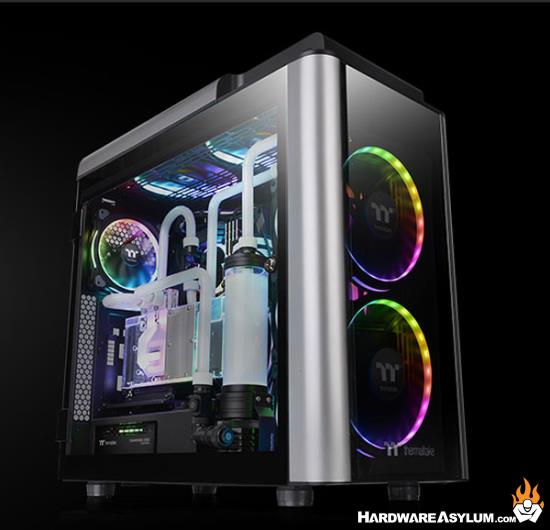
Exclusively “Tt LCS Certified”
Tt LCS Certifiedis a Thermaltake exclusive certification applied to products that pass the design and rigorous hardcore enthusiast standards that only the world’s best LCS chassis are held to. The Tt LCS certification was created so that we at Thermaltake can clearly convey to power users and enthusiasts which chassis are built and tested to be best compatible under extreme liquid cooling configurations. This ensures you get the best performance, compatibility and features.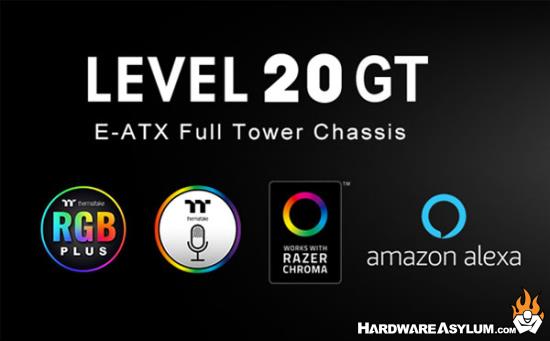
Preinstalled with 2 Riing Plus 20 RGB and 1 Riing Plus 14 RGB Fans
Thermaltake Riing Plus 20/14 Fan TT Premium Edition. 140mm/200mm high-static pressure fans with a patented 16.8 million colors LED ring and 12 addressable LEDs, the Riing Plus 20/14 RGB Fan features compression blades and hydraulic bearing, and can be controlled by the patented TT RGB PLUS Software and AI interactive voice control.Four Tempered Glass Panels
The chassis is equipped with four thick tempered glass panels on the front, top and both sides. The left and right hinged doors are also equipped with smart lock security systems to secure the inner components of your case.Superior Hardware and Liquid Cooling Support
Level 20 GT RGB Plus Edition Full-Tower Chassis supports up to E-ATX motherboards, CPU coolers up to 200mm in height, VGA lengths up to 310mm and PSU sizes up to 220mm in length.On top of this, Level 20 GT Edition Full-Tower Chassis is also fully capable of housing a complete liquid cooling system, including our range of PR-22 pumps and RGB Plus hardware.
Modern I/O Support (USB Type-C™ & USB 3.0)
The top-right panel features two USB 3.0 and two USB 2.0 data transfer ports, along with one USB 3.1 Type-C™ port.Patented Rotational PCI-E 8 Slots Design
Our brand new rotational PCI-E system allows you to install multiple GPUs either vertically or horizontally, depending on how you want to build your system.Vertical Radiator Placement
Whether you’re building a custom loop or running an AIO CPU cooler, the Level 20 GT RGB Plus Edition Full-Tower Chassis lets you mount your radiator against the back panel to show off your RGB fans. The back panel provides adequate exhaust while putting your RGB fans on display, with support for up to a 420mm radiator as well as radiator support on the front and top of the chassis.Sync with Razer Chroma Lighting
All Thermaltake TT RGB PLUS products are able to connect into the Razer Chroma ecosystem. Users who have installed both the TT RGB PLUS Software and Razer Synapse 3 can experience synchronized gaming and RGB lighting effects on their TT RGB PLUS liquid cooling system and gaming gear! From cooldown timers, health bars, and flashy ultimate indicators, to subtle ambient lighting that sets the perfect mood for each game, Razer Chroma provides an experience that transcends the screen and into your full setup, for a truly immersive experience.Works with Amazon Alexa
All Thermaltake TT RGB PLUS products support Amazon Alexa Voice Service, allowing you to control the lights or fan speeds by talking to the Alexa-enabled device. With the support of Amazon Alexa, TT RGB PLUS products also offer an additional visual cue for checking current weather condition in your location or anywhere in the world. All you have to do is simply starting the sentence with “Alexa, tell Thermaltake”, then the lighting color will correspond to the weather condition in the location.Availability, Warranty and Compatibility
Level 20 GT RGB Plus Edition and Level 20 GT Edition chassis will be available in August, 2018, via the Thermaltake worldwide network of authorized retailers and distributors. Level 20 GT RGB Plus Edition and Level 20 GT Edition chassis are backed by a three-year warranty and supported by the Thermaltake worldwide customer service and technical support network. -
NVIDIA Unveils Turing, Reinventing Computer Graphics
The hardware community has been buzzing about the next NVIDIA GPU wondering how fast it would be, speculating on the name and it really was just that, a speculation. Well, the wait is over, the new GPU is here.
During SIGGRAPH, the professional graphics conference in Vancouver Jensen Huang announced Turing, and more specifically the new NVIDIA Quadro RTX 8000, Quadro RTX 6000 and Quadro RTX 5000.
Sorry people no gaming GPU yet. I am humbled to realized that NVIDIA eluded to all of this at Computex but nobody was paying much attention it would seem
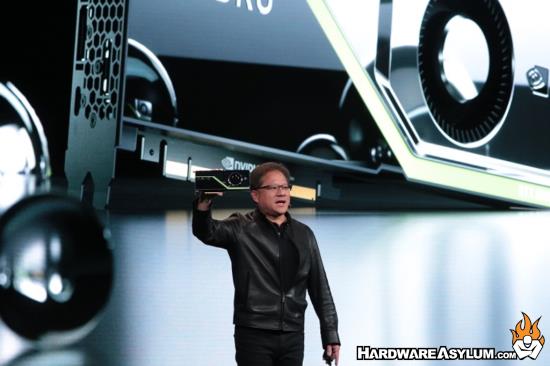
“This fundamentally changes how computer graphics will be done, it’s a step change in realism,” Huang told an audience of more than 1,200 graphics pros gathered at the sleek glass and steel Vancouver Convention Center, which sits across a waterway criss-crossed by cruise ships and seaplanes from the stunning North Shore mountains.
DellEMC, HPI, Hewlett-Packard Enterprise, Lenovo, Fujitsu, Boxx, and SuperMicro will be among the system vendors supporting the latest line of Quadro processors, he said. All three new Quadro GPUs will be available in the fourth quarter.
One thing that NVIDIA talked about during Computex is their new line of professional graphics computers, aka, Workstations built to use the power of NVIDIA graphics, this powerhouse is the basis of RTX Server and should put NVIDIA in the graphics and rendering space for a long time.
As if they weren't there already.
Another huge subject is "Ray Tracing". Anyone who has ever rendered a 3D image will know that the calculations required to do Ray Traced shadows is quite expensive. It is one of the major reasons it takes so long to render 3D animated movies and one of the stepping stones replicating the real world in computer games. With Turing NVIDIA claims this can be done in real time using dedicated RT (Ray Tracing) cores built into the GPU with a claimed 25x performance advantage over Pascal.
Of course the list of benefits goes on to include faster AI and generally faster rasterization performance. All things made possible by cranking that "stuff" up.

To read the full press/blog post check out the link below.
-
GIGABYTE Raises the X399 AORUS XTREME Motherboard
A Champion is Reawakened for the Arrival of New 32-Core AMD Ryzen™ Threadripper™ CPUs
City of Industry, California, August 8th, 2018 – GIGABYTE TECHNOLOGY Co. Ltd, a leading manufacturer of motherboards and graphics cards, today added the X399 AORUS XTREME as the top of the line motherboard, engineered to support the powerful AMD 2nd Gen Ryzen™ Threadripper™ processors with up to 32 cores. The new design is inspired by the prowess of the AORUS falcon with unique contours, commanding armor, and an eye into the future. A stunning spectacle of lights is incorporated to forge color-rich environments and memorable gaming adventures. The perfect match with these new CPUs is achieved through the use of a robust 10+3 digital power design coupled with enhanced thermal solutions, superior expansion capabilities and up to 4-Way CrossFire™/SLI configurations. Our signature audio with ESS SABRE DAC returns and connectivity is paramount using multiple USB Type-C™, triple LAN with 10 GbE and Intel® 2x2 dual band Wireless.
The new AMD 2nd Gen Ryzen Threadripper CPUs are built on 12 nm technology and utilize the prominent AMD TR4 socket. To deliver 3.0 GHz of base frequency with an incredible core count of up to 32 cores and 64 threads, these processors can peak at 250W of power, a figure only a vigorous and durable motherboard can withstand while maintaining stable operation.
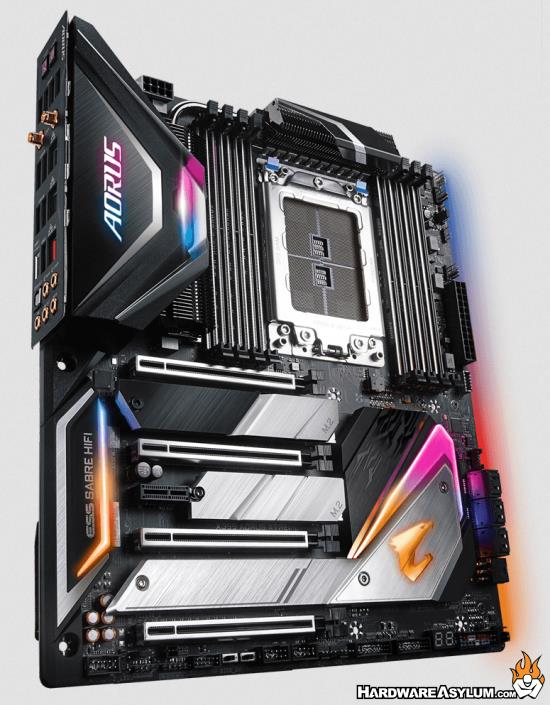
The X399 AORUS XTREME is in a class of its own equipped with a 10+3 power design using all digital PWM from IR accompanied by solid pin power connectors allowing energy sensitive components to enjoy a precise and reliable power delivery.
Thermal performance is of utmost importance and with this launch, AORUS presents an upgraded thermal design across the board. The critical VRM area takes advantage of the Direct Touch Heatpipe to rapidly transfer the heat from the components to the Fins-Array Heatsink, a design that increases the heat dissipation area by 300% when compared to traditional solutions. In case the airflow is not enough to rely on passive cooling, the X399 AORUS XTREME will automatically activate two 30mm fans cleverly located under the I/O Armor. The motherboard is prepared to operate under intense loads featuring a NanoCarbon base plate, an ingenious way to reduce the temperature of components mounted on PCB backside of the PCB.
Making the most out of the 48 of the 64 PCIe lanes directly provided by the CPU, the expansion slots on this motherboard allow for high-caliber setups with up to four graphics cards in CrossFire or SLI configurations. With this system, the level of immersion in games and VR experiences is phenomenal. To ensure a steady and consistant flow of power an additional 6-pin power connector was strategically placed on the motherboard to supplement the power delivery through the PCIe slots. Foreseeing the use of heavy graphics, the exclusive AORUS PCIe Armor and double locking brackets are essential to preserve the structural integrity of the slots.
Keeping up with this level of speed requires a strong disk performance. X399 AORUS XTREME boasts a triple PCIe Gen3 x4 M.2 design offering free support for ultra-fast NVMe RAID while enjoying the thermal throttling protection of triple Thermal Guards that elegantly mesh into the motherboard armor. The internal front panel USB 3.1 Gen2 Type-C connector adds yet another layer of high-speed connectivity to the motherboard.
Networking capabilities receive a massive upgrade on this model with Dual Intel® i210AT GbE LAN and a 10 GbE LAN port controlled by an AQUANTIA® chip for 10X faster transfer speeds and truly future-proof network configuration from the motherboard. Furthermore, Intel® Dual Band 802.11ac Wireless with BT 4.2 is also available to provide more connectivity at blazing fast speeds.
Users heavily rely on the quality of onboard audio to experience all forms of entertainment. The real-life sensations and vivid sound effects during games, movies, and music with the X399 AORUS XTREME are brought to life using the renowned Realtek ALC1220-VB audio codec, filtered by high-end audio capacitors and fine-tuned to audiophile levels by the ESS SABRE DAC.
The premium details on this motherboard extend to its back panel. The integrated I/O shield adds to user convenience during the assembly process while the gold-plated audio jacks complete a definitive Hi-Fi sound solution. A wide range of the best connectivity options as well as power and reset buttons grant a superior level of functionality and control.
X399 AORUS XTREME boasts a colorful multi-zone digital LED light show powered by RGB Fusion with the new added dimension created by underglow lighting. The ever-growing list of compatible hardware, multitude of effects together with the support for external RGBW and Digital LED strips result in the most advanced lighting system with virtually unlimited customization options.
Only a cooling technology with the prowess of Smart Fan 5 with FAN STOP is a reliable fit for a dominant platform. It leverages a number of hybrid fan headers and temperature sensors with the remarkable software suite to maintain system temperatures and noise under total control.
GIGABYTE prides itself on setting the highest standards in durability and, the X399 AORUS XTREME includes trademark features such as the Ultra Durable™ design with PCIe and Memory Armor, UEFI DualBIOS™ technology and all solid caps.
-
Pre-Sales Begin for 2nd Generation AMD Ryzen Threadripper Processor
Over 80 Global Retailers and System Integrators offer Immediate Pre-Order Opportunities of flagship 32-core, 64-thread 2nd Gen AMD Ryzen Threadripper 2990WX Worldwide —
SANTA CLARA, Calif. — Aug. 6, 2018 — AMD (NASDAQ: AMD) today announced immediate worldwide pre-order availability from over 80 global etailers and system integrators for the highly anticipated flagship 2nd Gen AMD Ryzen Threadripper desktop processor. Breaking the world-record Cinebench R15 multi-threaded CPU test with the highest benchmark scores in the single-socket desktop processor category, the 32-core, 64-thread 2nd Gen AMD Ryzen Threadripper 2990WX is designed for professional content creators, developers, and PC enthusiasts. The 2nd Gen line-up features four total processor models coming to market in 2018, all of which are built on the 12nm “Zen+” core architecture, include the unique 2nd Gen AMD Ryzen processor feature set, and are compatible with existing and new X399 motherboards. With the 2nd Gen AMD Ryzen Threadripper 2990WX and 2970WX processors, AMD adds the new Ryzen Threadripper WX Series above the existing Ryzen Threadripper X Series processors, meeting creators’ demands for the ultimate desktop computing power for the most intense workloads.
“We created a new standard for the HEDT market when we launched our first Ryzen Threadripper processors a year ago, delivering a ground-breaking level of computing power for the world’s most demanding PC users,” said Jim Anderson, senior vice president and general manager, Computing and Graphics Business Group, AMD. “Our goal with 2nd Gen Ryzen Threadripper processors was to push the performance boundaries even further and continue innovating at the bleeding edge. Beginning on August 13, creators, enthusiasts, and gamers everywhere will get to experience the benefits of these new products.”
During an event in front of global press, industry analysts, and partners last month, 2nd Gen Ryzen Threadripper 2990WX processors were put through their paces and have already broken world records in the Cinebench R15 multi-threaded CPU test. The AMD Ryzen Overclocking Team managed to push the 2nd Gen AMD Ryzen Threadripper 2990WX CPU to over 5.1GHz on liquid nitrogen, achieving record breaking performance with a score of 7,618, beating the current single socket record set by the competition’s Core i9-7980XE CPU at 5,828 points. The freely available Ryzen Master Software utility gives broad control of CPU[ii] settings allowing users to squeeze every drop of performance from their CPU.
2nd Generation AMD Ryzen Threadripper Desktop Processors Line-up
Following an aggressive 2018 roll out of global award-winning Ryzen mainstream desktop processors, the 2nd Gen AMD Ryzen Threadripper processor line-up is tailored to the needs of creators and gamers.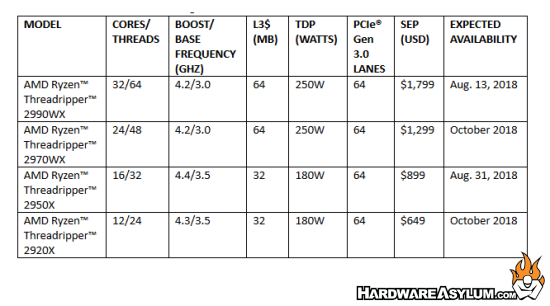
Ecosystem Readiness
All 2nd Gen AMD Ryzen Threadripper processors support the SocketTR4 platform, sporting sixty-four PCIe® Gen 3.0 lanes, and quad channel DDR4 memory with ECC support[iii]. All 2nd Gen AMD Ryzen Threadripper CPUs are supported by a full ecosystem of new and existing X399 platforms at launch, with designs already available from top motherboard manufacturers including ASRock, ASUS, Gigabyte, and MSI. Along with the broad selection of motherboards, the SocketTR4 platform supports a wide range of new and existing cooling solutions, including the new Wraith Ripper air-cooler showcased at Computex 2018. This cooler is now available from CoolerMaster and features compatibility with the SocketTR4 platform and all 1st Gen and 2nd Gen Ryzen Threadripper processors.Availability
For customers eagerly waiting for 2nd Gen Ryzen Threadripper desktop processors, etailers around the world are primed to begin taking pre-orders beginning today, Monday, Aug. 6, 2018, for the 32-core, 64-thread AMD Ryzen Threadripper 2990WX. A complete list of participating retailers and launch information can be found on www.AMD.com. The 16-core, 32-thread AMD Ryzen Threadripper 2950X CPU is expected to launch on Aug.31, 2018 and the AMD Ryzen Threadripper 2970WX and 2920X models are slated for launch in October 2018.At Siggraph 2018 in Vancouver, British Columbia, the globally acclaimed annual conference for creators kicking off on Aug. 12, AMD will host compelling demonstrations highlighting the possibilities enabled by the 2nd Gen Ryzen Threadripper processors for computer professionals – Booth 1101.
Customer & Partner Support
“At Fox VFX Lab we use AMD technology extensively. Our workstations are custom built, based on water cooled Ryzen Threadripper processors. Unreal engine artists easily peg every core at 100% during lightmass calculations,” said Ron Fischer, Director of Information Technology, Fox VFX Lab. “We work in real-time at the front of the production pipeline, and things move very quickly here, at the speed of imagination. AMD helps keep the pace as we define the future of virtual filmmaking.”“From film, TV, animation and motion graphics to art design & visual development, Jellyfish Pictures’ focus is delivering uncompromised creative artwork to the world” said Jeremy Smith, CTO at Jellyfish Pictures. “Our goal is to empower creative professionals to freely imagine, design, build and create without limitations, and with AMD’s Ryzen Threadripper we know we are offering unrivaled high-performance computing technology.”
Supporting Resources
Learn more about 2nd Generation AMD Ryzen Threadripper processors

